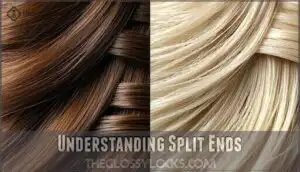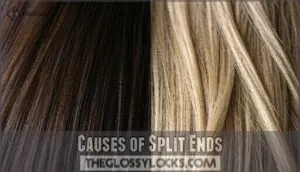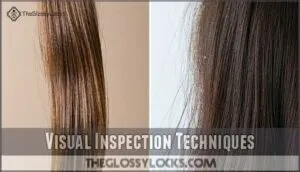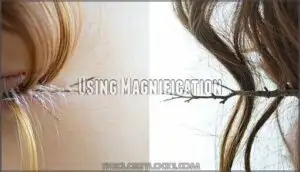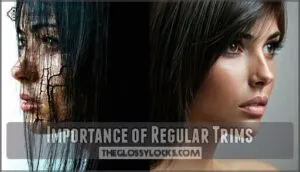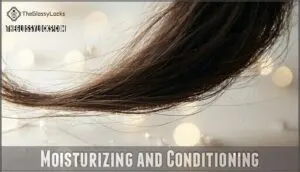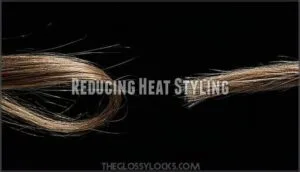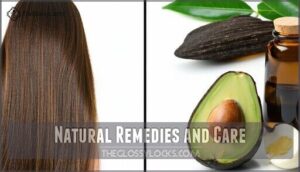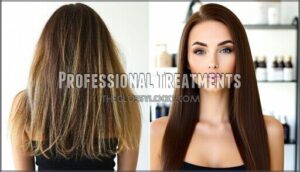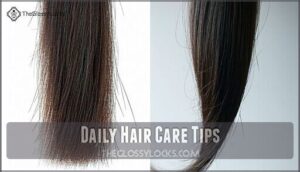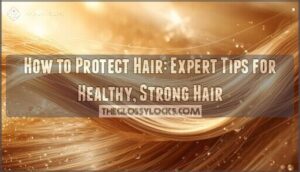This site is supported by our readers. We may earn a commission, at no cost to you, if you purchase through links.
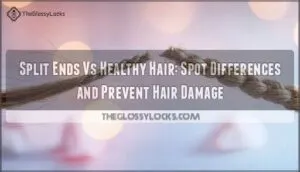
Split ends, on the other hand, are easy to spot—imagine frayed rope or brittle ends that snag or tangle. They happen when hair loses moisture or gets damaged by heat, styling, or harsh brushing.
A key difference? Healthy hair doesn’t break easily, while split ends often lead to breakage and thinner strands.
To prevent them, trim regularly, use conditioner, and avoid excessive heat. Think of it like caring for a delicate fabric—gentle handling goes a long way.
Curious about specific remedies? Let’s explore them further to find effective solutions and understand the importance of hair care.
Table Of Contents
- Key Takeaways
- Differences Between Healthy and Damaged Hair
- Understanding Split Ends
- Causes of Split Ends
- Identifying Split Ends
- Preventing Split Ends
- Natural Remedies and Care
- Professional Treatments
- Daily Hair Care Tips
- Beard Care and Split Ends
- Lifestyle Adjustments for Hair Health
- Frequently Asked Questions (FAQs)
- What causes hair to split and break?
- Can you actually repair split ends?
- Do split ends cause hair to stop growing?
- What do bad split ends look like?
- Is it healthy to pull split ends?
- Can split ends affect hair growth rate?
- How long does untreated hair splitting take?
- What role does scalp health play in splits?
- Are split ends more common in certain seasons?
- Can hair texture affect split end severity?
- Conclusion
Key Takeaways
- Inspect your hair regularly for frayed tips, Y-shaped splits, or rough texture to catch hair damage early.
- Trim split ends every 3-4 months to prevent them from spreading and maintain smooth, healthy hair.
- Moisturize and condition your hair consistently to lock in hydration and improve its elasticity.
- Reduce heat styling and use protective hairstyles to minimize hair damage and split ends.
Differences Between Healthy and Damaged Hair
Healthy hair looks smooth, shiny, and feels soft, while damaged hair appears dull, rough, and brittle.
By spotting these differences, you can take better care of your hair and prevent further damage.
Characteristics of Healthy Hair
Healthy hair is easy to spot when you know what to look for. It’s all about signs of great care and strong structure.
Great care and strong structure reveal the true beauty of healthy, vibrant hair you’ll love to show off every day.
- Soft Texture: Run your fingers through your hair—it should feel smooth, not rough. A soft texture means the cuticle layer is intact and protecting your strands.
- Natural Shine: Healthy hair reflects light, giving it a vibrant, shiny look. That’s your cuticle working to create that mirror-like effect.
- Hair Elasticity: Test a strand. Stretch it gently and see if it bounces back without breaking. Good elasticity is key to avoiding everyday damage.
- Moisture Balance: Your hair should retain moisture, not feel excessively dry or frizzy. Hydration keeps it manageable.
- Strong Ends: Check your tips. Healthy ends are smooth and clean, free from fraying or splitting, maintaining an even hair texture throughout.
Signs of Damaged Hair
Damaged hair often shows frizz and dullness, with a rough texture that feels dry to the touch.
Loss of elasticity means it snaps instead of stretching, leading to visible breakage signs and thinning. Split ends are a key indicator, branching like tiny “Y” shapes at the tips.
Higher porosity also makes damaged hair lose moisture quickly, leaving it brittle.
To address this, trim split ends regularly, hydrate with conditioners, and avoid excessive heat styling to strengthen and repair your strands effectively.
Understanding Split Ends
Split ends happen when the ends of your hair become frayed or split into sections, compromising its health and appearance.
Understanding the types and causes of split ends can help you prevent further damage and keep your hair looking its best.
Types of Split Ends
Split ends come in different shapes and tell unique stories of hair damage.
Here’s what to watch for:
- Y-Splits: Classic damage where hair branches into two, warning you of dryness.
- Tree Splits: Resembling a tree, these show excessive cuticle peeling and severe hair breakage.
- Feather Splits: Strands develop fine "feathers" at the ends—cuticle loss at its worst.
- Tapered Splits: Ends thin out substantially due to exposed, weakened cortex layers.
Each type signals hair needing trims and deep care.
Microscopic Appearance
When you take a closer look—literally—at hair under a microscope, the difference between healthy strands and those plagued by split ends (trichoptilosis) becomes crystal clear.
Healthy hair cuticles are like smooth shingles on a roof, shielding the cortex and medulla from damage. But split ends tell a different story. The cuticle looks torn and frayed, exposing the hair cortex and sometimes the medulla, leaving the hair shaft vulnerable.
Here’s a snapshot to compare their microscopic appearances:
| Layer | Healthy Hair | Split Ends |
|---|---|---|
| Cuticle | Smooth, intact | Lifted, ragged |
| Cortex | Packed, aligned protein fibers | Damaged, exposed |
| Medulla | Present in thick hair | May be absent or uneven |
| Hair Shaft | Uniform and strong | Weak, uneven, and brittle |
| Split Morphology | No splitting | Visible "Y" or tree-like splits |
Magnification levels reveal why prevention, like trimming and maintaining cuticle integrity, safeguards your strands.
Causes of Split Ends
Split ends happen when your hair is exposed to too much damage from heat, chemicals, or rough handling.
Even things like sun exposure, harsh weather, and a poor diet can weaken your hair over time, making it prone to splitting.
Physical Damage and Styling
Physical damage from hair styling is a major culprit behind split ends.
Your hair’s delicate structure can only handle so much! Here’s what to watch out for:
- Heat styling: Using flat irons or curlers dehydrates hair, causing hair heat damage and breakage.
- Brushing techniques: Vigorous brushing, especially on wet hair, leads to tears and hair damage.
- Tight hairstyles and hair extensions: Constant pulling weakens strands, creating split ends.
- Product buildup: Overusing certain products leaves residue, making hair brittle and prone to breakage.
Environmental Factors
Environmental factors can sneakily harm your hair if you’re not careful.
UV exposure acts like an overzealous spotlight, drying out strands and causing color to fade.
Air pollution clings to your hair, trapping dirt and moisture-stealing particles that lead to hair breakage.
Seasonal changes, especially windy or dry weather, leave hair brittle, making split ends more likely.
Humidity levels don’t help either—they leave your hair frizzy and puffy, harder to manage.
Even water quality plays a role.
Chlorine strips natural oils, while hard water deposits minerals that weaken strands over time.
To defend against this damage, follow hair care tips: use UV-protectant sprays to block sun damage and rinse with filtered water when possible.
Regular conditioning and protective hairstyles also help repair and fortify your hair’s natural resilience.
Nutritional Influences
After harsh weather strains your hair, poor nutrition can sneak in and make things worse.
Your hair thrives on good "fuel," but vitamin deficiencies, low protein intake, or lack of fatty acids put it on the backfoot.
Think of hair as a garden—without the right mix of hair vitamins, minerals, and hydration, it withers.
Iron and biotin keep strands strong, while omega-rich foods like salmon act as natural conditioners.
Skipping these hair dietary requirements weakens strands, creating brittle, thirsty hair prone to split ends.
Protein deficiencies further compromise hair strength.
Balance is key—focus on protein, hair minerals, and hydration effects for vibrant, split-free hair every day.
Identifying Split Ends
You can spot split ends by looking for frayed, uneven tips or little "Y" shapes at the ends of your hair.
Using a magnifying glass makes it even easier to catch tiny splits before they get worse, and this can be considered a key step in hair care.
Visual Inspection Techniques
Inspecting for split ends isn’t hard if you know what to look for.
Find a well-lit spot, and examine your hair closely.
Isolate single strands and check the ends for small splits or Y-shaped tips.
Use your fingers for texture analysis; roughness signals possible damage.
A magnifying glass or phone camera can reveal split ends with clarity.
Pay attention to inconsistencies in the hair shaft, like uneven thickness or fraying.
Spotting issues early helps prevent further hair damage and keeps strands healthy.
Using Magnification
Getting a closer look at split ends is easier with the right tools.
Using magnification benefits like a magnifying glass or high-resolution camera helps spot damage before it worsens.
Look for common signs of split ends:
- Y-shaped splits indicating damaged hair.
- Baby splits (tiny frays starting at the tips).
- Tree splits, where strands branch out like twigs.
A professional inspection with a microscope can reveal deeper issues in the cortex or medulla.
Early detection boosts chances for effective hair repair and long-term hair health improvement.
Preventing Split Ends
You can prevent split ends by keeping your hair moisturized, trimming it regularly, and avoiding excessive heat styling. Protecting your hair from damage guarantees it stays smooth, strong, and healthy.
Importance of Regular Trims
Trimming every 3-4 months isn’t just a chore—it’s your shortcut to split prevention and healthier hair.
It removes split ends before they creep upward, keeping strands strong and manageable. Plus, regular trims enhance length retention by preventing breakage, leaving your hair looking fresh and stylish without sacrificing growth.
Wondering how this applies to you? Use this simple guide:
Concern
**Why Trim?
| ** | Result | |
|---|---|---|
| Split Ends Spreading | Stops damage from traveling up strands | Healthier, smoother hair |
| Uneven Hair Appearance | Removes scraggly ends | Better style maintenance |
| Breakage Problems | Prevents excessive mid-shaft breakage | Length retention |
| Tangle Management | Reduces knots from frayed ends | Easier detangling |
| Healthy Shine | Promotes smoother cuticles | Natural shine and vibrancy |
Want sleek, healthy hair? Regular trims are your answer.
Moisturizing and Conditioning
Moisturizing hair is key for hydration benefits and preventing split ends.
Use conditioner types suited for your hair, like leave-in products to lock in hair moisture all day. Try oil treatments or deep masks weekly to boost hair moisture retention.
Apply conditioners after shampooing to soften and protect strands, focusing on the ends. Mask frequency depends on your hair, but once or twice weekly works well.
Many people find daily leave-in conditioner beneficial. Consistent hair conditioning and moisturizing hair keeps locks smooth, reduces breakage, and promotes lasting hair health with lasting health.
Reducing Heat Styling
Think of your hair as a treasure that thrives on gentle care.
Reducing heat styling is a simple way to protect it from split ends and keep it healthy.
- Embrace Heatless Styling: Try braids, twists, or buns before bed for natural waves or texture without heat.
- Switch to Air Drying: Skip the blow-dryer and let your hair dry naturally.
- Use Protective Products: Always apply a hair heat protectant if you use hot tools.
- Lower Temperatures: If you must use heat tools, lower the temperature setting to reduce hair damage.
- Explore Styling Alternatives: Rollers, flexi-rods, or clip-ins can add shape and volume without frying your hair.
Careful styling keeps hair damage and split ends at bay!
Natural Remedies and Care
You can nurture your hair naturally with simple remedies like marula oil or DIY masks that restore moisture and softness.
These methods protect against damage while keeping your strands healthy and strong over time.
Benefits of Marula Oil
Split ends need serious attention, and Marula oil hydration might be the perfect fix.
Lightweight yet nourishing, this oil gets absorbed quickly, moisturizing parched strands without leaving a greasy feel.
Packed with omega fatty acids and antioxidants, it strengthens hair, improves shine, and tames frizz effortlessly.
Marula oil also works wonders for scalp health, protecting against UV damage while soothing dryness, and it’s the go-to hair treatment for better shine enhancement and healthier hair.
Add this hair oil to your routine for visible results.
DIY Hair Masks
DIY hair masks are perfect for treating split ends and keeping hair smooth and healthy.
Try these simple recipes:
- Avocado & Honey: Mix one mashed avocado with a tablespoon of honey. It hydrates and softens dry strands, leaving them silky.
- Coconut Oil & Cinnamon: Combine two tablespoons of coconut oil with a teaspoon of cinnamon. It boosts scalp circulation for stronger growth.
- Egg & Olive Oil: Whisk one egg with two tablespoons of olive oil. The protein repairs damage, while olive oil adds moisture.
These masks offer deep conditioning benefits for various hair types. Apply weekly for best results!
Professional Treatments
You don’t have to handle split ends alone—professional treatments can help freshen up damaged hair and restore its smooth texture.
Options like keratin treatments and deep conditioning masks work wonders when your hair needs a little extra love and care.
Keratin Treatments
When split ends and frizz take over, a keratin treatment can be your hair’s secret weapon.
By smoothing the cuticle and boosting shine, it transforms damaged hair into manageable, healthy locks. However, beware of Keratin Side-Effects, as some treatments use formaldehyde, which may irritate eyes or cause coughing.
Treatment Longevity varies, lasting up to six months with proper aftercare. Consider using formaldehyde-free keratin options for a safer experience.
For Keratin Alternatives, natural oils or At-Home Keratin kits offer gentler options. Choose wisely to keep your hair strong and beautiful.
Deep Conditioning Masks
A deep conditioning mask is like a rescue mission for your hair, delivering intense hydration and repair to fight split ends.
It’s a simple, effective hair treatment to restore moisture and strengthen your strands. With the right mask ingredients and proper application techniques, you’ll see smoother, shinier hair almost instantly.
Here’s how to maximize mask benefits:
- Mask Ingredients: Look for argan oil, shea butter, or keratin in store-bought hair products, or try DIY recipes with avocado, honey, and coconut oil.
- Application Techniques: Apply generously to damp, clean hair, focusing on mid-lengths and ends. Cover with a shower cap for better absorption.
- Mask Frequency: Use once a week, or more often for damaged hair.
For enhanced results, consider using heat for penetration.
Your locks (and future self) will thank you!
Daily Hair Care Tips
Taking care of your hair daily can keep it smooth, shiny, and free of split ends.
Stick to gentle drying, detangling, and protective hairstyles to minimize damage and maintain healthy strands.
Gentle Drying and Detangling
A few tweaks to your drying and detangling routine can work wonders for healthy hair. First, pick the right towel material—microfiber is best—to blot, not rub, wet hair. Rubbing causes friction, roughing up the cuticle and leading to frizz and split ends.
Let hair air dry whenever you can to avoid heat stress. For hair tangles, use wide-tooth combs. Always start at the ends, gently work upward, and consider sectioning hair to reduce pull.
Detangling sprays make this task easier—perfect for stubborn knots. Remember, wet hair is weaker, so go slow and steady during hair combing. Consider using a gentle hair drying method to minimize damage.
Check out these techniques:
| Task | Right Way | Wrong Way |
|---|
Gentle care keeps your hair resilient for the long haul!
Protective Hairstyles
Protective hairstyles are a simple way to prevent split ends and keep your hair healthy.
They focus on low manipulation and moisture retention, ensuring style longevity and hair breakage prevention.
- Wrap it up: Use a silk scarf or satin bonnet for night protection.
- Braid softly: Loose braids minimize tangles and keep ends safe.
- Switch pillowcases: Satin ones reduce friction, protecting strands.
- Use silk ties: Avoid harsh elastics that tug hair painfully.
- Be gentle: Wide-toothed combs prevent breakage during product application.
Beard Care and Split Ends
Your beard can face split ends just like the hair on your head, leaving it rough and unkempt. With the right care, you can keep it healthy, smooth, and impressive.
Recognizing Beard Split Ends
Beard split ends can sneak up on you, making your once-pristine facial hair look rough and unkempt.
They’re tiny troublemakers that fray the tips of your beard and ruin its appearance.
To spot them, look for thinning tips, a coarse texture, or Y-shaped splits at the ends.
You might also notice your beard is harder to style or doesn’t hold its shape as well.
Preventative beard care starts with using hydrating beard techniques like applying quality beard oil.
Beard oil benefits include added moisture, shine, and smoother hair ends.
Comb your beard with a saw-cut or horn comb to avoid snagging and minimize damage.
And, of course, trimming beard splits regularly keeps them from spreading further.
By paying attention to your beard’s health and maintaining a routine, you’ll preserve its smoothness, style, and overall hair health.
Beard split ends can sneak up on you, making your once-pristine facial hair look rough and unkempt.
They’re tiny troublemakers that fray the tips of your beard and ruin its appearance.
To spot them, look for thinning tips, a coarse texture, or Y-shaped splits at the ends.
You might also notice your beard is harder to style or doesn’t hold its shape as well.
Preventative beard care starts with using hydrating beard techniques like applying quality beard oil.
Beard oil benefits include added moisture, shine, and smoother hair ends.
Comb your beard with a saw-cut or horn comb to avoid snagging and minimize damage.
And, of course, trimming beard splits regularly keeps them from spreading further.
One key preventative measure is avoiding excessive heat, which can severely damage the hair.
By paying attention to your beard’s health and maintaining a routine, you’ll preserve its smoothness, style, and overall hair health.
Beard Maintenance Tips
Spotting split ends in your beard might’ve raised some questions about upkeep.
Keeping a beard in top shape isn’t rocket science, but it does take regular care. Start with a trim every 1-2 weeks—precise trimming techniques guarantee no scraggly edges or budding split ends.
Washing 2-3 times weekly with a gentle beard shampoo removes dirt while keeping the natural oils intact; over-washing can dry it out.
Beard oil is your beard’s best friend—it softens the hair, hydrates the skin, and improves overall hair appearance. Use a wooden comb or boar bristle brush to detangle and spread the oil evenly.
Protect your style with light beard styling products like a balm. Add a healthy diet rich in biotin and protein, and your beard stays strong, soft, and split-free.
Lifestyle Adjustments for Hair Health
Your daily habits play a big role in keeping your hair healthy and free of split ends.
Simple changes, like eating a balanced diet and managing stress, can make a noticeable difference in your hair’s strength and shine.
Diet and Nutrition
In the context of healthy hair, what you eat matters just as much as the products you use. Your hair thrives on the right nutrients, so think of your plate as a toolkit for hair nutrition.
- Protein Intake: Hair is mostly keratin, a type of protein, so bad protein habits can lead to weak strands or dull texture. Add lean meats, eggs, tofu, and legumes to strengthen and thicken your hair.
- Hydration Effects: Healthy fats, like omega-3 fatty acids, are your go-to for locking in moisture. Find them in salmon, walnuts, chia seeds, and flaxseeds for shiny, hydrated hair.
- Antioxidant Benefits: Vitamins A, C, D, and E promote scalp health and protect against damage. Bright veggies like carrots and peppers pack these nutrients.
- Mineral Absorption: Low iron, zinc, or selenium leads to sluggish growth. Boost minerals with spinach, pumpkin seeds, or oysters for stronger hair growth.
Reducing Stress
Stress hormones can wreak havoc on your hair health, slowing hair growth and even causing split ends.
Scalp tension from stress impacts your emotional wellbeing and disrupts your hair care routine.
Prioritize holistic health by adding yoga, meditation, or deep breathing to your day.
These techniques relax your mind and scalp while supporting healthy hair, remembering that less stress means less "hair stress"—and happier strands overall.
Frequently Asked Questions (FAQs)
What causes hair to split and break?
Dryness, heat, and chemicals are your hair’s worst enemies.
Over-styling, harsh brushing, and sun exposure weaken strands, making them split or break.
Protect your hair by moisturizing, trimming regularly, and using heat protectants.
Can you actually repair split ends?
You can’t truly repair split ends, but you can temporarily smooth them with treatments like oils or masks.
The only permanent fix is trimming them off, so grab some scissors or visit a stylist!
Do split ends cause hair to stop growing?
Split ends don’t stop hair growth, but they sabotage your length goals.
Like a frayed rope, they cause breakage and thinning.
Regular trims prevent them from traveling up the strand, keeping your hair healthier and stronger.
What do bad split ends look like?
Bad split ends look frayed, like tiny tree branches or a fuzzy “Y” at the tips.
You’ll notice rough, dry edges that tangle easily, feel brittle, and make your hair look dull and unkempt, which can be described as having frayed ends.
Is it healthy to pull split ends?
It might seem harmless, but pulling split ends is like peeling a scab—it only makes things worse.
It weakens your strands, causing more fraying.
Instead, trim them off cleanly with sharp scissors to stop damage.
Can split ends affect hair growth rate?
Split ends don’t impact your hair’s growth rate directly, but they cause breakage, making it harder to retain length.
Regular trims and proper care help you protect your strands, keeping them healthy and growing strong.
How long does untreated hair splitting take?
Hair splitting spreads like a bad rumor—once it starts, it doesn’t stop.
Without trims, splits can travel up the strand, weakening your hair over weeks or months, leaving it dull, frizzy, and prone to breakage.
What role does scalp health play in splits?
Your scalp’s health directly affects hair strength.
A clean, nourished scalp promotes robust hair growth, reducing brittleness that leads to splits.
Treat it right—think gentle massages, moisturizing oils, and avoiding harsh products—your hair will thank you, and this will lead to overall healthy hair.
Are split ends more common in certain seasons?
Think of winter’s chill and summer’s sizzle as double trouble for your hair.
Cold air dries strands, while sun and heat weaken them, making split ends more common in extreme seasonal shifts.
Stay hydrated!
Can hair texture affect split end severity?
Your hair’s texture absolutely affects split end severity.
Fine hair is more prone to splitting because it’s delicate, while coarse or curly hair can tangle easily, causing friction and breakage, especially if not properly moisturized.
Conclusion
Picture running your fingers through hair that’s smooth and snag-free—no split ends in sight.
Achieving this means understanding the differences between split ends vs healthy hair and taking simple, consistent steps.
Trim your hair regularly, keep it hydrated with conditioners, and limit heat styling to protect your hair from damage.
Treat your strands gently, like your favorite silk scarf, and with a little care, you can maintain its strength and enjoy healthier, fuller-looking locks every day.


